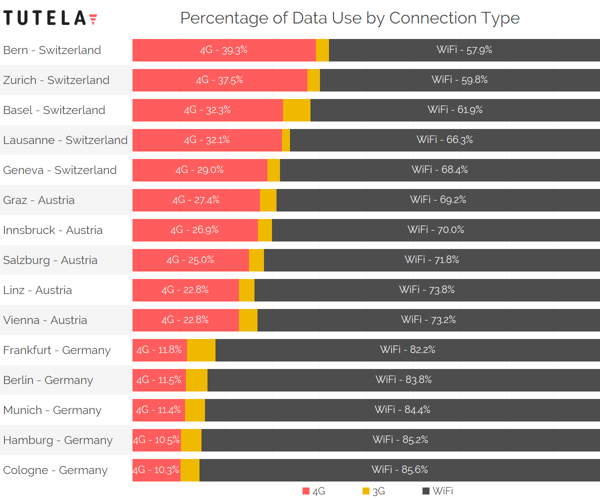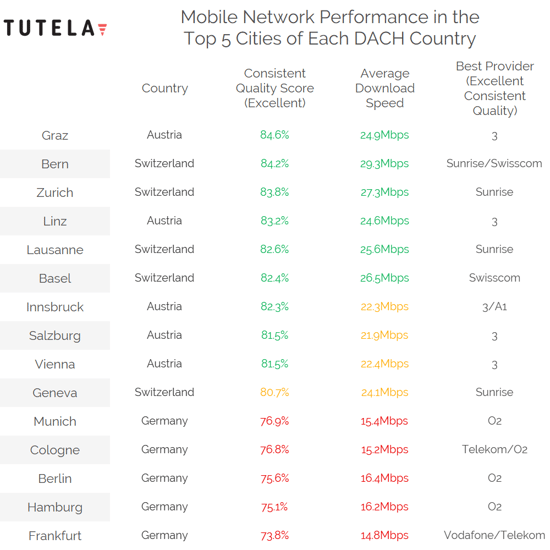Germany
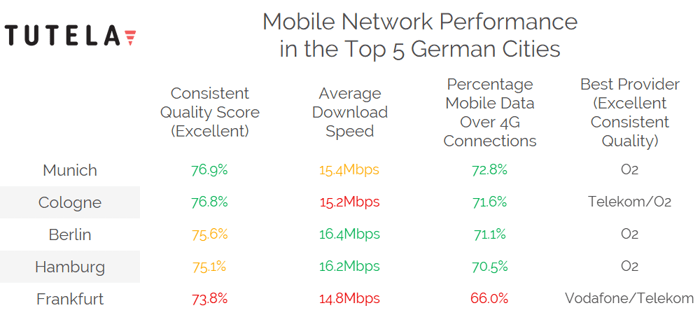
The last few months have been exciting for the German telecoms market, with the conclusion of the BNA multiband spectrum auction that saw 1&1 Drillisch transition from being purely an MVNO to having a foundation to build out a full network operator. However, it is too early to see the impact this move will have on the consumer mobile experience across the country. As the country begins to prepare for 5G, what is striking even in the large German cities is the lower rates of 4G than in similar countries around the world. Specifically, the percentage of mobile data usage over a 4G connection in Germany was significantly lower than in other parts of the DACH region - ranging from 66% in Frankfurt up to just under 73% in Munich. All cities tested in both Austria and Switzerland had significantly higher percentages of mobile data traffic over 4G, ranging from 85% up to just over 95%.
As with most countries, Germany’s top five largest cities had higher excellent consistent quality than the national averages of its operators in the recent Tutela State of Mobile Networks report. Munich finished top with 76.9% of tests meeting Tutela’s excellent consistent quality thresholds, likely as a result of its higher percentage of mobile data over a 4G connection compared to the other German cities tested. O2 placed first, either on its own or jointly with another operator, for excellent consistent quality in four of the five cities, despite having come second nationally for excellent consistent quality in Tutela’s previous report.
Meanwhile, Berlin had the fastest average download speed at 16.2 Mbps, and the highest average data usage per day. This was despite finishing third of the five for excellent consistent quality.
Berlin
Germany’s capital, Berlin, finished middle of the ranking of the largest five German cities for consistent quality, although provided the highest average download speed among the tested cities at 16.4 Mbps.
By operator, O2 had the highest excellent consistent quality at 77.2% – significantly above second- and third- place Telekom and Vodafone, who are a statistical tie on this metric. This was despite both Vodafone and Telekom being faster than O2. Vodafone’s speed advantage over second-place Telekom was 3.3 Mbps, while O2 was the slowest network overall at a highly respectable 14.6 Mbps. Vodafone’s average of 20.4 Mbps was the fastest average download speed observed in any of the five cities in Germany.
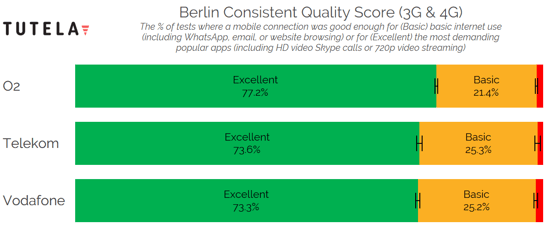
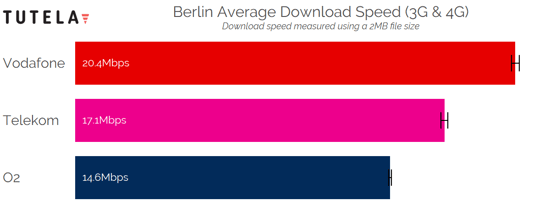
Cologne
In Cologne, O2 and Telekom tied on excellent consistent quality, despite Telekom’s network being 5.4 Mbps faster in terms of average download speed. Vodafone, meanwhile, was at least six percentage points behind the leader, despite having the second fastest average download speed at 17.8 Mbps.
Cologne tied with Frankfurt for the lowest daily data usage per user. Despite having the second highest percentage of data traffic go over a 4G connection, Cologne had the second slowest average download speed at 15.2 Mbps, just ahead of Frankfurt.
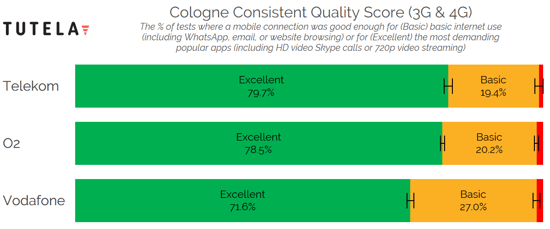
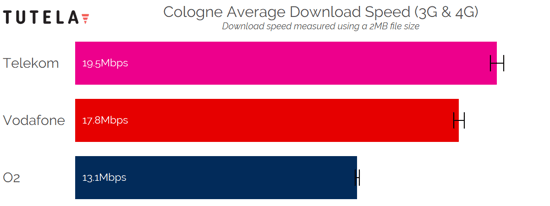
Frankfurt
Vodafone and Telekom tied for first-place in excellent consistent quality in Frankfurt, with Vodafone placing first for average download speed with an average of 18.1 Mbps. O2 was third for both excellent consistent quality and download speed, although it was close on excellent consistent quality with just 3 percentage points separating it and the highest score recorded in the city. However, its network had an average download speed 5.7 Mbps slower than the leader, Vodafone.
Frankfurt had the lowest percentage of mobile data traffic travel over a 4G connection (66%), the lowest daily data usage per user, and the lowest average download speed in Germany at 14.8 Mbps.
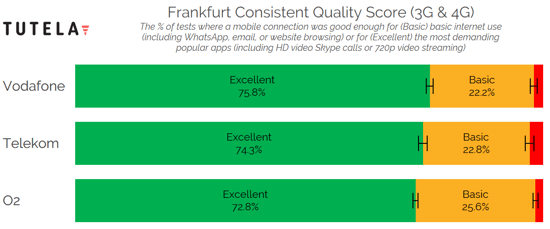
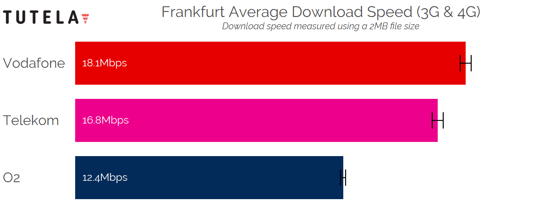
Hamburg
In Hamburg, O2 had the highest excellent consistent quality, with 78.1% of tested connections meeting Tutela’s thresholds. While Telekom was clearly second, over 5 percentage points behind O2, Vodafone was a close third with just 2 percentage points separating it and Telekom.
However, Vodafone was the fastest network tested in Hamburg, with an average download speed of 18.8 Mbps. Telekom and O2 placed second and third, with an average speed of 15.6 Mbps and 15.1 Mbps respectively.
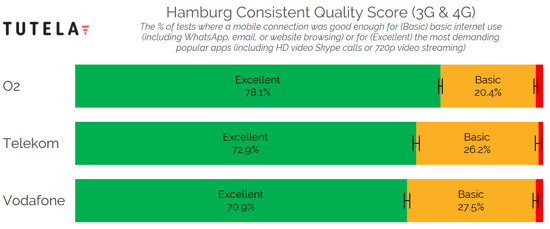
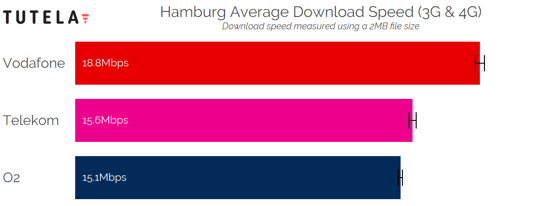
Munich
Munich had the highest excellent consistent quality in Germany, at 76.9%, although it placed middle of the pack for German cities by average download speed at 15.4 Mbps.
By operator, O2 had the best excellent consistent quality in Munich at 79%, with Vodafone coming second and Telekom third. Vodafone was the fastest network in the city, with an average download speed of 19.3 Mbps.
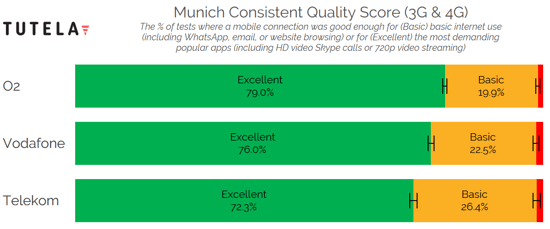
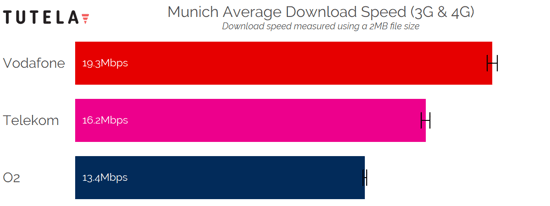
Austria
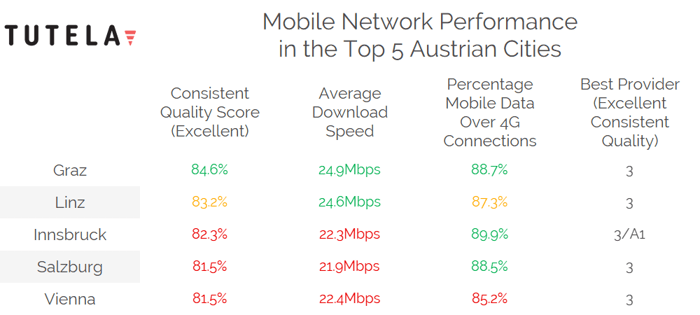
Austria is slightly ahead of Germany in the race to 5G, with its 3.5 GHz spectrum auction having completed in March of this year, and all operators in the process of deploying trials and rollouts in parts of the country. For example, Magenta has launched its first 25 transmission stations, predominantly in rural areas, while 3 has looked at consolidating its urban performance with trials at its Vienna headquarters and a live 5G network in the city centre of Linz. A1 Telekom meanwhile signed a 5G deal with Nokia, and conducted its first 5G live data connection in Gmünd back in January.
Taking a step back from a bright potential future for Austrian operators around 5G, the current state of Austrian telecoms is encouraging. In Tutela’s national level State of Mobile Networks report, 3 had the highest overall excellent consistent quality at 82.7%. This is a trend echoed at the city level with all five cities tested either having 3 as the outright leader for excellent consistent quality, or jointly first alongside A1. Upload speeds below the 2 Mbps threshold was the single biggest reason for operators receiving sightly lower percentages, however all operators in the five Austrian cities had over 75% of tests meet or exceed the excellent consistent quality threshold.
Graz in Austria came top overall of the DACH table for excellent consistent quality, and there was significant competition between Swiss and Austrian cities -- however, all Austrian cities outperformed German cities tested on the consistent quality metric.
Austria also had higher percentages of mobile data over 4G than Germany, although on the whole this was less than the Swiss cities tested, with the exception of Basel in Switzerland, which had uncharacteristically high rates of 3G data use.
Average download speeds in Austria were much more competitive. While Tutela’s national report found 3 to have the highest average download speed across the country, A1 Telekom had the highest average download speed in three of the five Austrian cities tested, tying with 3 for the fastest download throughput in the remaining two. �
Graz
Graz had the highest excellent consistent quality (84.6%) and average download speed (24.9%) among the five cities tested in Austria.
3 was the outright winner for best excellent consistent quality at 88.1%, tying with A1 for fastest download speed with both offering averages in excess of 25 Mbps. Magenta finished third for both consistent quality and average download speed – although it still had an excellent consistent quality percentage of 81.3%, which on an international basis is still extremely good, but not enough to rival other operators within Austria. Notably, Magenta also had a number of tests not even meet the basic threshold, which is representative of less demanding mobile data use cases like VOIP calling or SD video streaming.
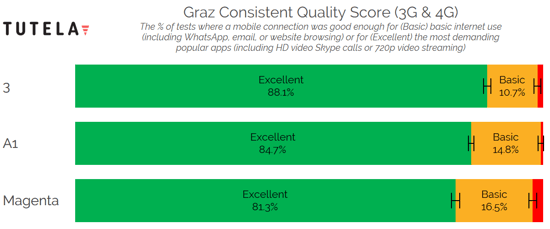
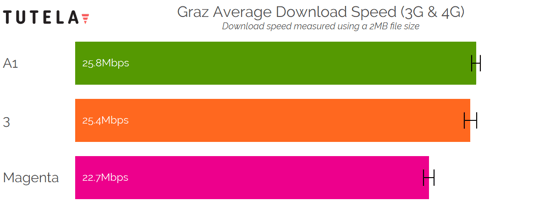
Innsbruck
Despite A1 having a 3.6 Mbps speed advantage in Innsbruck, 3 and A1 tied from a statistical perspective for excellent consistent quality, with up to 86% of tests meeting Tutela’s excellent quality thresholds. Magenta placed third for excellent consistent quality, with over 20% of tests not meeting the excellent threshold and some tests not even meeting the basic quality threshold. This was despite 3 and Magenta tying for second place on average download speed, with both networks offering average speeds of approximately 21 Mbps.
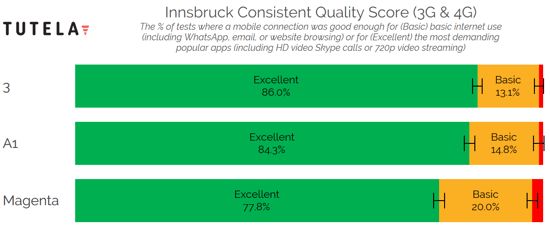
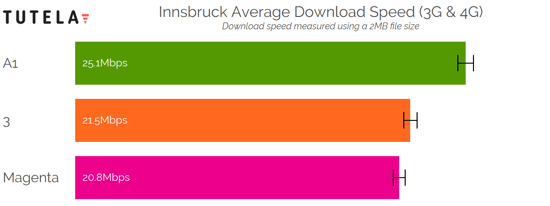
Salzburg
For mobile users in Salzburg, 3 had the highest excellent consistent quality at 86.4%, and 3 and A1 tied for fastest average download speed, with both exceeding 23 Mbps. Magenta had its lowest excellent consistent quality score among the five cities tested – however, more than three quarters of tests still exceeded the thresholds that Tutela uses to represent reliable performance during the most intense use cases that mobile users regularly undertake, such as HD video streaming and group video calling.
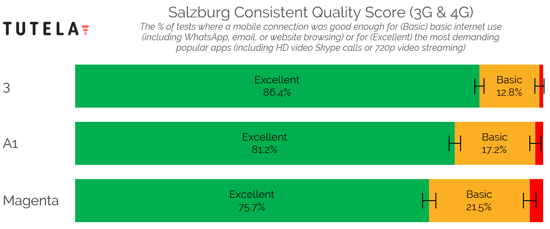
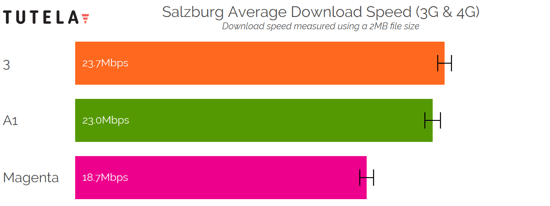
Linz
In Linz, which came second in Austria among the five cities tested for both excellent consistent quality and average download speed, 3 came first for excellent consistent quality, with 87.0% of tests meeting Tutela’s thresholds representing reliable connection quality for use cases such as HD video streaming or HD group video calling. However, A1 placed a close second with 85.0% of tests meeting the same criteria. A1 was the fastest network overall, a full 5.2 Mbps faster than 3, and 7.9 Mbps faster than third place, Magenta.
Linz will be an interesting area to watch from a mobile networks perspective, as earlier this month, 3 announced it had launched its own 5G network in the city centre for a select group of customers.
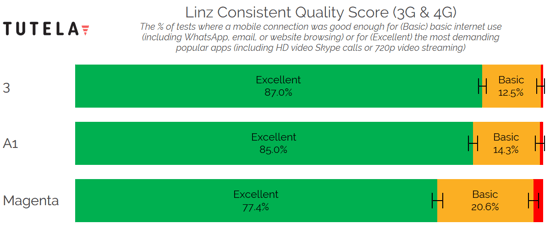
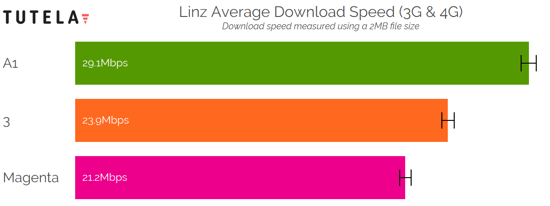
Vienna
In Austria’s capital, 3 provided the highest excellent consistent quality, with over 84% of tests meeting the required threshold. Overall, this was 3’s lowest excellent consistent quality score among the five cities tested, although given the additional traffic likely found in capital cities thanks to their higher population, it was still an extremely impressive showing. A1 came second for excellent consistent quality, but had the fastest average download speed at just short of 24 Mbps.
Vienna had both the highest data usage per user per day in Austria, and across the DACH region more broadly. However, compared to the four other Austrian cities tested, Vienna came last for both excellent consistent quality and average download speed, with a very respectable result of 81.5% and 22.4 Mbps respectively.
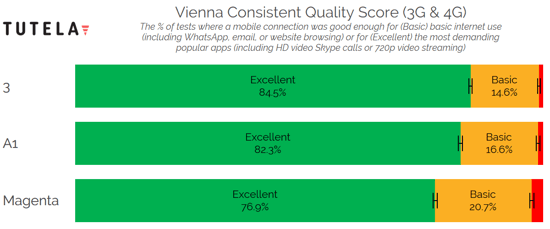
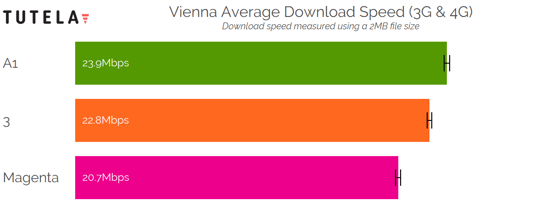
Switzerland
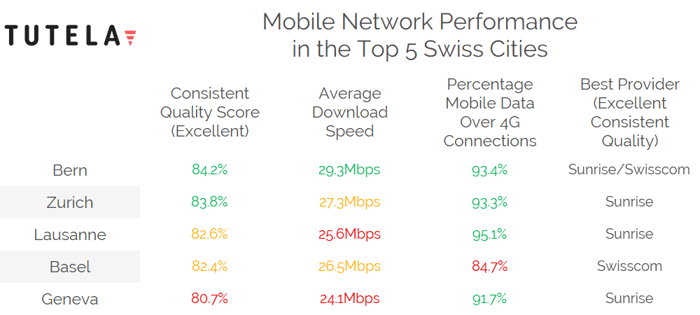
Despite some regional doubts and resistance, as well as strict EMF limits, 5G is storming ahead in Switzerland. Already, Swisscom has announced it is on track to supply 90% of the population with 5G by the end of 2019, which would be one of the broadest and most rapid 5G rollouts of any country. However, Switzerland’s track record for excellence is notable, and can be seen in this report through the sheer percentage of urban traffic going over a 4G connection, especially compared to the rest of the DACH region. All cities other than Basel showed high levels of 4G penetration with over 90% of mobile data going over a 4G connection.
The five largest Swiss cities performed highly competitively compared to Austria, and outperformed those tested in Germany. Bern and Zurich placed second and third respectively in the cross-DACH region comparison. Within Switzerland, Bern placed top for both excellent consistent quality and highest average download speed.
Overall, Sunrise was the leading operator for consistent quality among the five largest cities, either coming first outright or drawing with Swisscom (Bern) in four of the five cities tested. This follows Sunrise’s impressive 85.1% national excellent consistent quality, which saw it place first among the Swiss operators in Tutela’s DACH State of Mobile Networks report previously. Swisscom had the highest average download speed in every one of the cities tested, reflecting their national win for average download speed in the previous national report.
Basel
In Basel, where 4G data usage as a percentage of overall mobile data usage was noticeably lower, Swisscom lead in both excellent consistent quality (86.7%) and average download speed (33.6 Mbps). Sunrise was second for excellent consistent quality, but finished third for average download speed, just behind Salt.
Swisscom’s average download speed was particularly impressive as the highest recorded for any single operator in any of the five major cities from each country tested in this report.
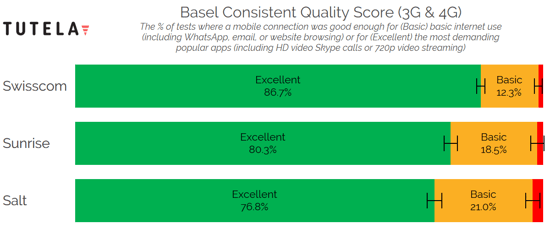
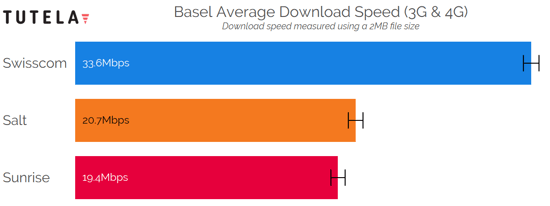
Bern
Switzerland’s federal city, Bern, led the way for Swiss cities with both the highest excellent consistent quality (84.2%) and average download speed (29.3 Mbps). While Bern lost out to Graz in Austria for the highest excellent consistent quality result, its networks averaged the highest average download speed at 29.3 Mbps.
Looking at operators, Sunrise and Swisscom tied as providers of the highest level of excellent consistent quality in Bern, while Salt finished third, over ten percentage points behind the two winners (73.5% compared to 86.3% and 86.6%).
Swisscom excelled in providing the highest download speed, with an average of 33.5 Mbps. This was just short of 10 Mbps faster than the average for second-place Sunrise, although all three operators provided fast speeds that far exceed the download throughput thresholds within Tutela’s excellent consistent quality metric.
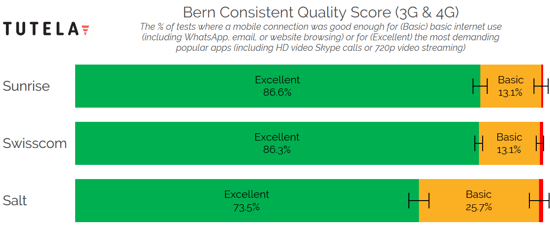
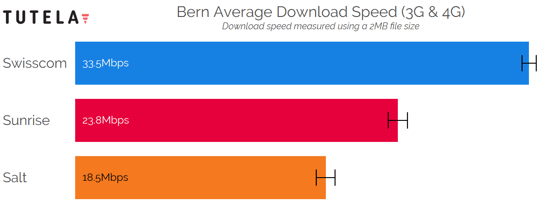
Geneva
In Geneva, Sunrise had the highest excellent consistent quality, with 87.1% of tests meeting or exceeding Tutela’s thresholds in upload and download throughput, latency, jitter and packet loss. Meanwhile, Swisscom had the fastest average download speed at 28.9 Mbps. Salt, which placed third for both excellent consistent quality and average download speed, had its lowest overall excellent consistent quality result among the five largest Swiss cities in Geneva. However, 71.7% of tests still met Tutela’s excellent consistent quality requirements, suggesting that the vast majority of the time, the network performs reliably for use cases like HD video streaming.
Salt’s results may go some way to explaining why Geneva placed last overall for excellent consistent quality, although over 80% of connections in the city met or exceeded Tutela’s excellent consistent quality thresholds.
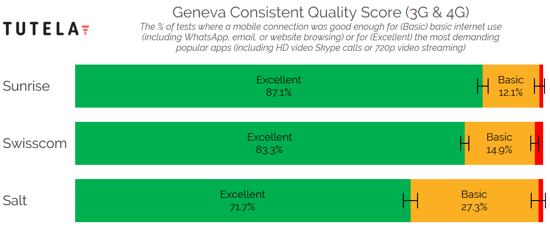
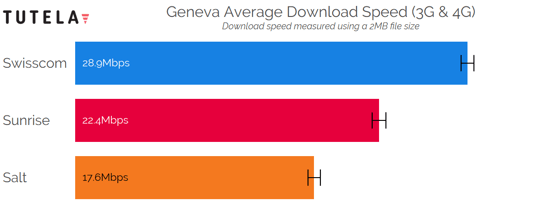
Lausanne
Lausanne overall had the highest percentage of mobile data traffic in both Switzerland and across the DACH region over a 4G connection, with 95.1% of mobile data traffic over this technology. Despite this, Lausanne placed third among the five Swiss cities tested for excellent consistent quality (82.6%), and fourth for average download speed (25.6 Mbps).
Sunrise had the highest excellent consistent quality in Lausanne at 89.9%, followed by Swisscom at 85.3%, and Salt in third at 73.6%. In the average download speed ranking, Swisscom and Sunrise switched places with Swisscom coming first at a blistering 30.0 Mbps.
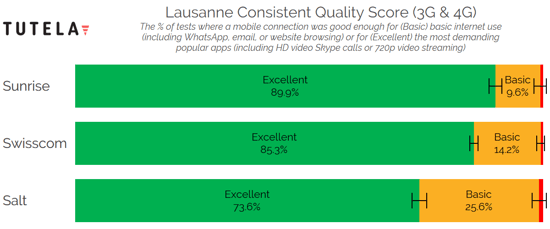
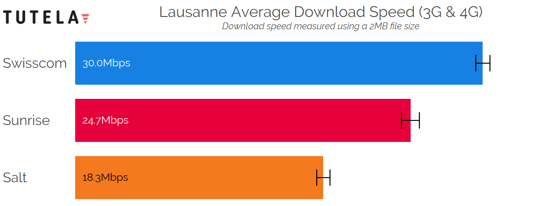
Zurich
Zurich, Switzerland’s largest city, placed second in Switzerland for both excellent consistent quality and average download speed, at 83.8% and 27.3 Mbps respectively. Zurich also had the highest average data usage per user per day in Switzerland (the second highest among the fifteen DACH cities).
The results were extremely close on an operator level when looking at the excellent consistent quality ranking, however Sunrise emerged top with 87.2% of tests meeting or exceeding Tutela’s thresholds. Swisscom came a close second at 85.2%. As in other parts of Switzerland, Swisscom remained the fastest network.
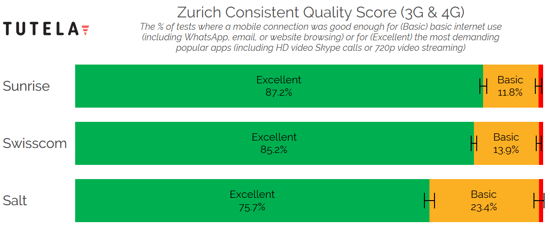
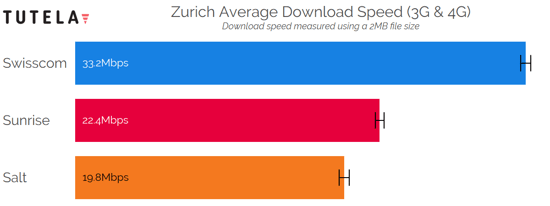
Methodology
Tutela measures network quality based on the real-world performance of users in the field. Results in this report are based on a testing configuration to represent typical (not maximum) performance of users. We used a 2 MB file to perform our download testing and a 1 MB file to perform our upload testing. Tutela employs software installed on more than 3,000 partner apps to complete frequent, lightweight tests using 2 MB files.
Our results differ from other network testing companies which measure the peak performance of networks under ideal conditions (such as downloading a 200 MB file).
In total, Tutela’s software operates on over 250 million Android and iPhone devices globally, collecting over 10 billion mobile data measurements every day. Our data scientists analyze results for each country every month, and our analytics platform, Tutela Explorer, lets operators chart, map, and filter over 80 key performance indicators into customized dashboards to help them better understand industry performance and benchmark against competitors.
Subscribe to our latest insights
Sign up to Tutela Insights to view all of our complimentary mobile experience reports and subscribe below to
get our latest insights in your inbox each week.
